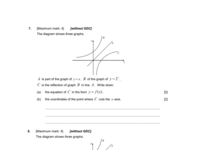Log graph transformations
Keywords
| English | Japanese | Korean | Chinese Simplified |
| Logarithmic Function | 対数関数 | 로그 함수 | 对数函数 |
| Sketch | スケッチ | 스케치 | 草图 |
| Graph Transformation | グラフの変換 | 그래프 변환 | 图形变换 |
| x-intercept | x軸との交点 | x-절편 | x轴截距 |
| Domain | 定義域 | 정의역 | 定义域 |
| Inverse Function | 逆関数 | 역함수 | 逆函数 |
| Exponential Function | 指数関数 | 지수 함수 | 指数函数 |
| Asymptotes | 漸近線 | 점근선 | 渐近线 |
| Range | 値域 | 치역 | 值域 |
| Base Change | 底の変換 | 기수 변경 | 底数变换 |
| Vertical Asymptote | 垂直漸近線 | 수직 점근선 | 垂直渐近线 |
| Different Bases | 異なる基底 | 다른 기수 | 不同基数 |
| Exponential Equations | 指数方程式 | 지수 방정식 | 指数方程 |
| Growth and Decay Models | 成長と減衰のモデル | 성장 및 감소 모델 | 增长与衰减模型 |
| Transformations | 変換 | 변환 | 变换 |
| Horizontal Shift | 水平シフト | 수평 이동 | 水平移动 |
| Vertical Shift | 垂直シフト | 수직 이동 | 垂直移动 |
| Function-inverse Relationship | 関数と逆関数の関係 | 함수-역함수 관계 | 函数与逆函数的关系 |
| Reflection over the line y=x | 直線y=xに関する反射 | 선 y=x에 대한 반사 | 关于y=x的反射 |

2. Horizontal Shift: - Transform to match . - Use the applet to slide the horizontal shift control and observe the changes. - Record observations on the horizontal shift's effect on the graph.
3. Vertical Shift: - Apply a vertical shift to get - Slide the vertical shift control to see the graph move up by 1 unit. - Discuss the impact on domain and range.
4. Asymptote Identification: - Identify the new vertical asymptote for the transformed function . - Use the applet to display the equation of the asymptote and confirm if it matches . - Explain the asymptote's significance to the function's domain.
5. Domain and Range Analysis: - Confirm the domain and range of using the applet. - Reflect on the reasons behind the domain restriction and the range being all real numbers.
6. Inverse Function Exploration: - Explore the inverse function . - Use the applet to show the inverse function and its reflection over the line . - Sketch or capture both and on the graph with the line .
7. Conclusions: - Summarize the effects of horizontal and vertical shifts on the logarithmic function. - Discuss the function-inverse relationship in the context of logarithmic functions. Reflection Questions: 1. How does changing the base of the logarithm affect the graph's shape? 2. What happens to the graph of if you subtract inside the logarithm (e.g., ? 3. How would the domain and range change if the logarithmic function were reflected over the x-axis?

